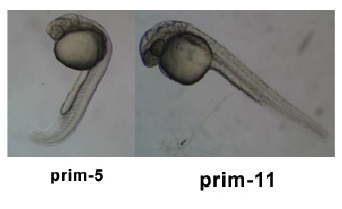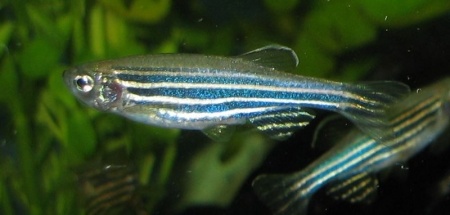2009 Group Project 3: Difference between revisions
| Line 23: | Line 23: | ||
==History of Model Use== | ==History of Model Use== | ||
[http://www.nature.com/nrg/journal/v3/n9/fig_tab/nrg892_I1.html Timeline of the development of the zebrafish as a model organism] | |||
===In the Begining... George Streisinger (December 1927 - August 1984)=== | ===In the Begining... George Streisinger (December 1927 - August 1984)=== | ||
Revision as of 11:31, 23 September 2009
ZebraFish
Background Information
Model organisms, particularly vertebrates, have been researched extensively in science to reach a greater understanding of human embryo development without facing the ethical issues such studies would arouse if performed on human embryos. They are used, not only in the study of development of a healthy embryo but also for the study of diseases and in particular the role genetics plays in the presence and development of such diseases.
Why zebrafish?
Among these models, the zebrafish is one of the most useful due to particular unique characteristics which allow it to be more easily studied than others. These advantages include the high proliferation rate of the zebrafish (something which is important for the study of genetics) and in addition to this, scientists are able to maintain them in breeding condition all year round. The fertilisation of the zebrafish is an external process; this means that the gametes can be fertilized individually by scientists, allowing for the manipulation of genetic material for the purpose of study of individual genes and the roles they play. Also, the unique transparency of the zebrafish embryo allows scientists to closely observe the development of the phenotypes without disturbing the process of development, allowing for the observation of the development of individual embryos from beginning to end.
"‘You can see different cell types, watch individual cells develop, do transplantation experiments’, Eisen enthuses, ‘and development is quick but not too quick’. Being able to watch individual neurons developing in real time opened up whole new avenues of research for Eisen and other neurobiologists."
(Bradbury, 2004)
This is different to the study of other embryos in that their development must cease in order to dissect the embryo for study. This hinders the study of the embryo greatly, forcing scientists to effectively ‘fill in the gaps’ of information they could not observe due to the disruption of embryo development.
History of Model Use
Timeline of the development of the zebrafish as a model organism
In the Begining... George Streisinger (December 1927 - August 1984)
The use of the zebrafish as a model organism began in the late 1960s when a scientist at the University of Oregon,
George Streisinger, chose to study it based not only on the many advantages stated above but also on his love for tropical fish.
Streisinger wanted to analyse mutants among the zebrafish in order to study embryological development and stated that his aim was to “study features of the organisation and embryological development of the vertebrate nervous system through the use of mutant strains” (Grunwald and Eisen, 2002). In order to do this, he decided that first the phenotypes showing rare recessive mutations must be used to reproduce heterozygous offspring. It wasn’t until 1976 that Streisinger and fellow scientist, Charline Walker managed to produce wholly or partially homozygous offspring using sperm to activate an egg but in such a way that the sperm (genetically impotent due to UV damage) did not contribute to the genetic make-up of the offspring. In order for the eggs to remain diploid without gaining an extra set of chromosomes, the second meiotic division was inhibited, giving the offspring the entire set of chromosomes needed. This allowed for much ease in mapping out genes and correlating them with phenotypes.
Charles Kimmel
Streisinger was not the only scientist working on the embryologic development of the zebrafish. Neurologist Charles Kimmel (also at Oregon) used the zebrafish to model the development of the nervous system and vertebrae and by the mid- 1970s, Kimmel uncovered the segmental structure of its brain.
Hesitations
Problems soon arose in the form of doubt when it came to using a zebrafish to understand human genetics. “There was little theoretical appreciation of the degree to which vastly diverged species would share the regulatory pathways that govern cell behaviour and embryonic development” (Grunwald and Eisen, 2002). At the time, there was no gene cloning and little understanding about genes, making the whole zebrafish project almost a gamble to follow through with. This put much strain on the funding given to Streisinger and the credibility of his work. This however did not affect Neurologists such as Kimmel as they were not much worried about the relevance of their work. According to them, as long as they were studying nerve cells, it was all relevant.
Taking the Plunge
The Institute of Molecular Biology at the University of Oregon seemed to nurture the gamble-like quality in Streisinger’s work and provided him with the right environment as well as facilities to develop his model. The attitude of the institute was one which encouraged personal endeavours and above all else, it was important to be “committed to answering a question” (Grunwald and Eisen, 2002).
Once a method to produce heterozygous diploids was established, non- mutant strains of zebrafish were created and then specific mutations induced to study the phenotype and genotype relations. A 1981 issue of Nature journal published the first article pertaining to the zebrafish research which outlined the methods used by Streisinger to produce the homozygous clones of the zebrafish.
Around this time, Kimmel had “described more identifiable neurons in the zebrafish than had been recognised in any other vertebrae” (Grunwald and Eisen, 2002). They also traced the growth of the axons of spinal cord motor neurons. The common ground on which Streisinger and Kimmel based their work lead to a collaborative effort to record “patterning and differentiation of the nervous system” (Grunwald and Eisen, 2002).
In 1982, Kimmel began a 10 year program to “illuminate the developmental steps that led to the origin and organisation of distinct tissue types in the zebrafish embryo” (Grunwald and Eisen, 2002). Although Streisinger died in 1984, the project went on to describe a crucial stage in embryonic development which occurred just before gastrulation. This study was groundbreaking as the step described was the one in which the entire body plan emerged for the embryo, giving future researchers a conceptual framework (or map) from which to explore and monitor the development of cells. It also “placed the zebrafish in the context of vertebral biology” (Grunwald and Eisen, 2002).
That is, when corroborated with the work of embryologists of other species, it provided common principles of development for all vertebraes, leading Kimmel to claim excitedly “the fish is a frog... is a chicken... is a mouse” (Grunwald and Eisen, 2002). This illustrates the dawning of the idea that genetic and biological organisation is the same among a great range of animals, and that by studying any one of these vertebrates, it was possible to learn more about humans.
The Big Screen
Through combining the use of embryological, genetic and neurological studies, the 1980s saw Kimmel and other scientists exploring various gene mutations of the zebrafish. By combing these studies with other such studies of homologous genes and their phenotypes, mutations were found to exist across a range of animals.
For example, a zebrafish with no tail was found to have a mutation in the same gene as that of a mouse with no tail. Such findings interested Drosophila developmental geneticists and compelled them to begin a research program on the zebrafish by the late 1980s. The main aim of such a program, as led by Nusslein-Volhard (winner of a Nobel Prize for her work with the Drosophila) and Wolfgang Driever was to replicate “Drosophila screen for embryonic pattern mutants in a vertebrate” (Grunwald and Eisen, 2002). This program, later known as the ‘Big Screen’, began in 1993 and finished in 1996 and the resultant 37 papers (describing 4000 embryonic lethal mutants) were all published in volume 123 of the journal Development
The Big Screen had an enormous impact on the scientific community, pushing the zebrafish as the latest promising research model for embryology and the roles of genetics in disease and development. “The model for genetic analysis of development and physiology that had been established in Drosophila had been extended fruitfully to new vertebrate problems” (Grunwald and Eisen, 2002). The mutations described by the report were useful for the study of genetic disease processes across a range of vertebrates, including humans.
Around this time, a research team of undergraduate students, under the watchful eye of John Postlethwait, developed a method by which molecules across the zebrafish genome could be tagged and then used to map out genetic mutations. This development of a linkage map provided the tools needed for genetic analysis through positional cloning. Positional cloning is a process used to identify and locate a gene by first identifying its phenotype and then, using its already known approximate position on a chromosome (called the candidate region), narrowing down the position until the gene in question and its mutants are found.
Timeline and Stages of Embryonic Development
| Duration | Period Name | Image |
| 0 - 0.75 hrs | Zyogote Period | 
|
| 0.75 - 2.25 hrs | Cleavage Period | 
|
| 2.25 - 5.25 hrs | Blastula Period | 
|
| 5.25 - 10.33 hrs | Gastrula Period | 
|
| 10.33 - 24 hrs | Segmentation Period | 
|
| 24 - 48 hrs | Pharyngula Period | 
|
| 48-72 hrs | Hatching Period | 
|
| 72 hrs - 30 Days | Larval Period | 
|
| 30- 90 Days | Juvenile Period | |
| 90 Days - 2 yrs | Adult Period |
Genetics of the ZebraFish and Embryology
The Danio rerio (zebrafish) genome has not yet been fully sequenced. It is made up of 25 pairs of chromosomes and is approximately half the length of the human genome. As of September 2, 2009, 1,540,405,905 base pairs have been sequenced of an estimated total of 2,011,659,089 bps.
Current Sequencing Status: http://www.sanger.ac.uk/Projects/D_rerio/
Danio rerio Genome Sequencing Project
Zv8, the 8th integrated Whole Genome Shotgun assembly of the zebrafish was released in June, 2008 by the Wellcome Trust Sanger Institute. This project gives us a genome length of 1,481,241,295 bps and the accompanying gene sets is comprised of 24,147 genes which code proteins.
For more information on the Zv8, visit http://www.sanger.ac.uk/Projects/D_rerio/wgs.shtml.
Genetics and Embryology
The zebrafish provides an excellent model for the study of vertebrate development. Embryonic development of the zebrafish takes place externally and the embryo is completely transparent. Development is simple and rapid, developing to a free swimming larva 120 hours after fertilisation, with a generation time of 10-12 weeks.
Current Embryology Research
The most commonly used organism for studies of development and function is the zebrafish embryo. The zebrafish embryo has been observed for many years, from 1980s to 2009. Although the embryo was consistently studied continuously over the years, it was most commonly utilized in 2004-2006 from the use of the zebrafish in drug testing to fighting cancer to being the first blueprint of a vertebrae embryo. Recent developments have allowed for further understand about genetics; expression and function, eye disorders, organ and vertebrae development as well as reproductive studies. Recent studies utilize the zebrafish embryo due to its rapid proliferation rate and the transparency of the embryo.
Genetics
One of the most significant characteristics of the embryo is the notochord, a midline structure required for skeletal development of the vertebrae and as the main central structure through which the embryo develops. The Laboratory of Molecular Genetics and Developmental Biology, China isolated a contig of expressed sequence tags from the zebrafish ovary. This cDNA sequence was cloned and expressed within the oocyte, which further progressed through the cleavage stage to the blastula stage. At gastrulation, the specific gene sequence was evident in the dorsal region, restricted to the notochord and pectoral fin, during embryonic development at 48 and 72 hours. Hence the zebrafish notochord related gene (znrg) was established due to its abundant availability in the notochord, which was determined to play a vital role in notochord development within the zebrafish.
Expression & Function
The zebrafish has been utilized to express the gene of lissencephaly LIS1, which is a severe disease associated to brain malformation. The zebrafish exhibits two LIS1 genes; LIS1a and LIS1b. Proliferation and migration deficiencies in neural and brain development arise when the LIS1 gene is mutated or depleted. It was determined that the LIS1 genes were present within the protein and genetic structures and were expressed during embryonic development, within mature tissue samples. The LIS1 gene was predominately evident within the brain tissue and when the LIS1 gene was destroyed, it resulted in developmental deficiencies such as brain malformation, circulation and structural abnormalities. This study determined that the LIS1 gene plays a vital role in embryonic development, especially in relation to brain formation.
Cancer Research
In 2005, under the guidance of Mary J.C. Hendrix from the Northwestern University Feinburg School of Medicine, Illinois, a laboratory implanted the embryo of a zebrafish with human melanoma cells; these cells divided but did not express themselves as tumors within the embryo. They were, however maintained as plastic phenotypes, expressing specific cell types, including endothelial, neural and stem cells. Hendrix stated that cancer cells are unspecific, plastic phenotypes that are similar to embryonic stem cells. Due to the ability of the zebrafish embryo to maintain the plastic phenotype and to suppress the tumor from forming in the microenvironment, Hendrix hypothesized that there may be a causal relationship between the formation of cancer cells and the role of the environment. Hendrix therefore concluded that further study into the factors that suppressed the formation of tumor cells in the zebrafish, could potentially reverse the phenotype of tumor cells.
Eye Disorders
Nephronophthisis (NPHP) is a cystic kidney disease, caused by mutations of nine genes and is also associated to cerebellar defects, situs inversus and retinitis pigmentosa, where the mutation of NPHP5 and NPHP6 is associated to progressive blindness. It was determined that gene products, such as nephrocystin5 and nephrocystin6, contribute in maintaining photoreceptor homeostasis. Zebrafish embryos were utilized to analyze the genetic interaction of the gene products, once NPHP5 and NPHP6 was depleted. The following link provides further information about the usefulness of the zebrafish as a model for eye disorder research. http://www.youtube.com/watch?v=ZItgyfuxsfM
References
Websites
http://dev.biologists.org/cgi/content/abstract/dev.022673v1
http://www.zfic.org/classroom%20experiments/stagingindex.html
http://zfin.org/zf_info/zfbook/stages/stages.html
http://www.swarthmore.edu/NatSci/sgilber1/DB_lab/Fish/fish_stage.html
http://classic.sidwell.edu/us/science/21bio/new/staging_files/v3_document.htm
http://www.eurekalert.org/pub_releases/2005-06/nu-tzt060205.php- Tiny Zebrafish teaches Researchers how to Fight off a Deadly Cancer 20-Jun-2005
http://www.youtube.com/watch?v=ZItgyfuxsfM Eye Disorders and Zebrafish
http://www.eusem.com/main/read-eye EUSEM- EU Science Education Media
Articles
Stages of embryonic development of the zebrafish ; [PMID: 8589427] [PubMed - indexed for MEDLINE]
Znrg, a novel gene expressed mainly in the developing Notochord of Zebrafish. Zhou Y, Xu Y, Liu Y, Zhang Z and Deng F. The Laboratory of Molecular Genetics and Development Biology; College of Life Science, Wuhan University, China. 2009 Aug 20. [PMID-19693699]
Expression and Function on embryonic development of Lissencephaly-1 genes in Zebrafish. Sun C, Xu M, Xing Z, Wu Z, Li Y, Li T and Zhao M. State Key Laboratory of Molecular Biology, Institute of Biochemistry and Cell Biology, Shanghai Institutes for Biological Science, Shanghai, China. 2009 Aug; 41(8):677-88. [PMID-19657569]
Genetic & Physical Interaction between NPHP5 and NPHP6 gene products. Schafer T, Putz M, Lienkamp S, Ganner A, Bergbreiter A, Ramachandran H, Gieloff V, Gerner M, Mattonet C, Czarnecki PG, Sayer JA, Otto EA, Hildebrandt F, Kramer-Zucker A and Walz G. Renal Division, University Hospital Freiburg, Germany. 2008 Dec 1;17(23):3655-62. [PMID: 18723859]
ANAT2341 group projects
Project 1 - Rabbit | Project 2 - Fly | Project 3 - Zebrafish | Group Project 4 - Mouse | Project 5 - Frog | Students Page | Animal Development





